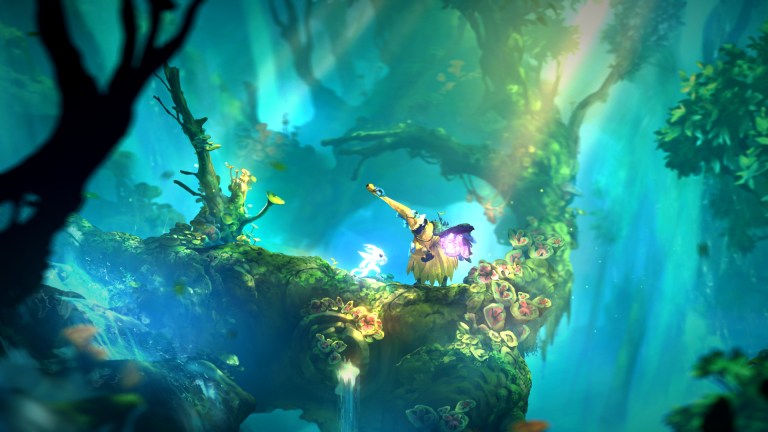Ori and the Will of the Wisps Review
Ori and the Will of the Wisps provides an enchanting but frustrating new forest to explore.

Ori and the Will of the Wisps is by turns graceful and frustrating. Mostly similar to the first entry in the series, landscapes are now even more vibrant and colorful. Elements that make the game bigger than its predecessor, like a charming town-building subplot, are unobtrusive and welcome. With that expanded scope come debilitating bugs, though, which made speeding through the game for review more difficult. Frame rate stutter, animation glitches, and crashes plagued my experience with Ori and the Will of the Wisps. A day-one patch released to address these issues fixed the stutter but not all of the crashes on my Xbox One.
That said, the story is charming enough. After Ori’s owl friend Ku gets lost in a storm, you search for him through the tangles and dungeons of a new forest. The first area brings the same delights as the first game in the series: strange creatures, vivid greenery, engaging puzzles. The improved graphics make everything cuter and more beautiful. I just about squealed at Ori trailing glittering drops of water as they flung themselves through a delicate waterfall.
With a story structure and environments similar to Ori and the Blind Forest, the sequel almost feels more like more of a refinement than a continuation. That familiarity isn’t necessarily a bad thing since the first game was also a joy.
Will of the Wisps also features many returning powers and re-acquiring them can sometimes feel like a chore. But overall, I enjoyed the new combat, which allows for a lot more customization. Instead of your primary weapon being ranged magic, the sequel offers a choice of weapons, abilities, and ways to interact with the environment, all on a convenient abilities wheel. New abilities can be found through Spirit Shards, which add everything from near-essential traits like sticking to walls to trade-off effects that maximize the difficulty and the reward. You can only hold three at first, but unlock more through combat shrines.
Unfortunately, one of Ori and the Blind Forest’s best quirks is missing from the sequel. Ori’s ability to save anywhere, once a selling point, is now gone—and why shouldn’t it be? In the last five years, games have mostly shed any emphasis on manual saves, either doing it automatically as Will of the Wisps does or living always online. The loss doesn’t change the rhythm of strategizing to face some of the game’s many puzzles or bosses, which still feel fun and fresh, despite being hurt by technical issues.
Release Date: March 11, 2020
Platforms: Xbox One (reviewed), PC
Developer: Moon Studios
Publisher: Xbox Game Studios
Genre: Metroidvania
I’m almost thankful to the bugs for allowing me to get good use out of the staggered save files, which let you drop back into the minutes before you fell through a wall or realized you’d walked the wrong way. The combat is so well-calibrated, the windows of opportunity so perfectly sized, that it’s especially frustrating when you know something is chugging by milliseconds. Boss battles were more of a problem, with frequent crashes and broken effects. Coming in at the end of a console generation makes some of this inevitable, with developers forced to work in anticipation of customers playing on a wide variety of machines.
The level design is usually delightful. Ori and his bioluminescent world feel more alive than ever, mushrooms and trees moving in the wind. Enemies are bigger and they interact with the environment like forces of nature. Ori is a tiny spark in comparison, but the animation and feel of attacks make it perfectly plausible that you’re staggering these hulks. I particularly enjoyed a musical puzzle that changed up the usual rhythm of the game by asking you to play a song. The Midnight Burrows section also introduces some pleasant teleport puzzles that reminded me of Portal.
At their best, the puzzles are an utter joy to solve. It’s play in the generic sense: imaginative, curious. I want to explore every corner, to feel the reward of discovering what prize I can grab behind every candy-colored puzzle. This is the uncomplicated joy of video games: problem-solving in a beautiful and entertaining world. I found myself looking forward to classic elements instead of worrying about whether they were repetitive. There’s even a desert level!
In other sections, the difficulty feels forced. Especially toward the later areas, obstacles feel less like intricate puzzles and more like walls placed in the way to keep you from using your late-game abilities in interesting combos. In the Baur’s Reach section in particular, the carnivorous plants felt less like a fun new mechanic and more like an arbitrary barrier. The long set-piece chases start out visually inventive, then become essentially a game of pinball that leave you trying to find the sequence of moves that will let you fly through the area.
The series has an essential undercurrent of kindness, plus effectively ominous villains, and both are on display here as you discover more about the skeletal owl Shriek. All of the creature designs, especially Shriek and the giant frog Kwolok, are full of personality and have unique silhouettes. Ally characters react to your actions in the game and build a village with the resources you provide throughout the game.
The bare-bones story feels like a fairy tale. New to this series, there are now NPCs and map-sellers, many of whom are looking for knowledge about the world around them. The answers always have a flavor of a fairy tale: without the light, the world has gone to decay. That unobtrusive lore, along with the stories of several creatures being driven from their homes, feels mythic and simple. The village, in particular, is an effective metaphor for why exactly you’re fighting. There are people here to save, and you’re not done. It’s still a village in dark times; it’s not home. Not yet.
At times, I didn’t want to put Ori and the Will of the Wisps down. Solving puzzles and discovering new ways to use Ori’s powers was so very entertaining. Just like the first game, the world of the sequel is fun to traverse and explore. Then I’d encounter a bug, or a horde of enemies requiring split-second timing, and the life would leach out. The wounded forest would become a broken machine, Ori stuck in the cogs. But if you want more of the beautiful art and joyful exploration the first game brought, you’ll find it here.

